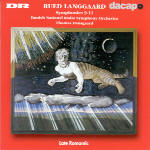These three symphonies neatly illustrate three major musical strands that Rued Langgaard pursued throughout his checkered and idiosyncratic compositional career. Symphony No. 9, subtitled “From Queen Dagmar’s City” (the city in question being Ribe), was composed in 1942 but reflects a self-conscious return to the conservative German Romantic tradition of Bruch, Reinecke, and Mendelssohn. As might be expected, it’s very pretty, high on charm, light in substance, and none the worse for that. Symphony No. 10 “Yon Hall of Thunder” (1944) follows the Strauss/Scriabin school of late-Romantic excess. A single movement lasting 25 minutes, it might be thought of as Denmark’s answer to “Death and Transfiguration”. There’s some really exciting stuff here, with Langgaard’s curious use of three piccolos adding an extra measure of brilliance to the scoring.
Symphony No. 11 “Ixion” was composed in the same year as No. 10 but lasts only a bit more than six minutes. It consists entirely of a thickly scored, demented waltz tune that wants to sound festive but winds up getting blasted by the percussion through one jarring key change after another. It’s sarcastic, bitter, pointless music. What makes it work at all (and the same may be said for the other two symphonies as well) is that Langgaard’s structures always are remarkably concise given the idiom employed. He makes his point and moves on, which is no small gift in any composer, let alone one whose life’s work consists of a somewhat schizoid search for a coherent musical syntax. Thomas Dausgaard and his orchestra do a marvelous job in the Symphonies 9 and 10 (for the third movement of No. 9, which quotes an old carillon tune, the actual bells of Ribe cathedral were even dubbed in). No. 11 could have been made to sound even wilder with a bit more oomph from brass and percussion, and the sonics could have been slightly clearer, but this is very minor stuff. If you’ve waited this long to try Langgaard, start here.
































